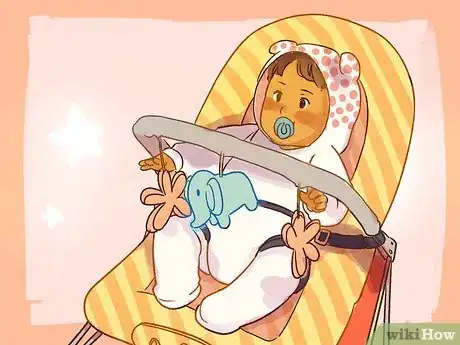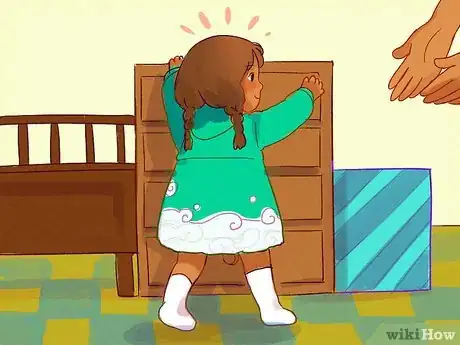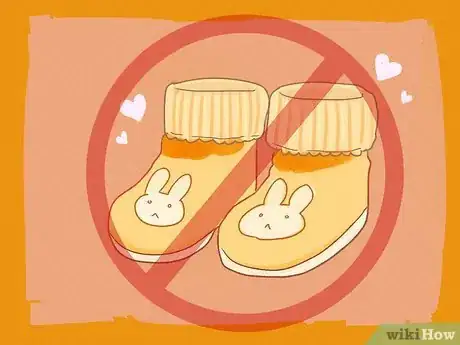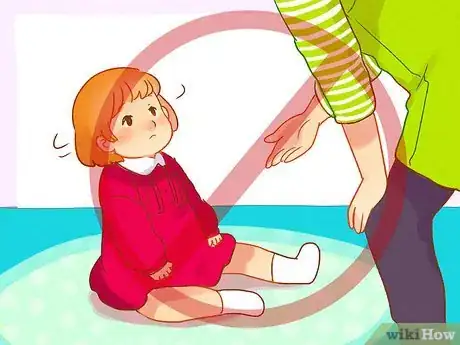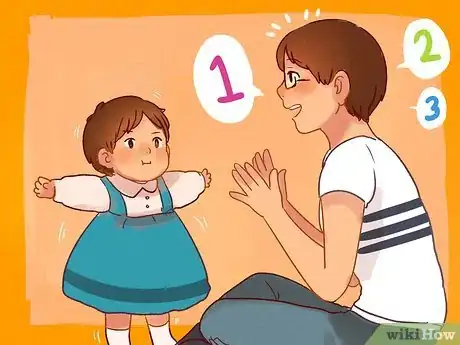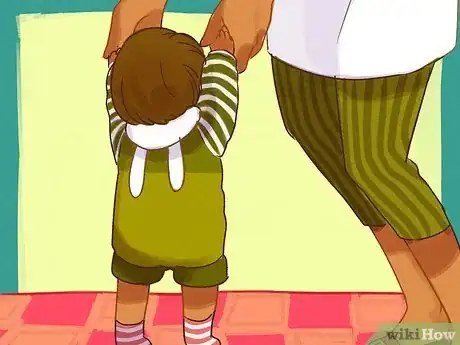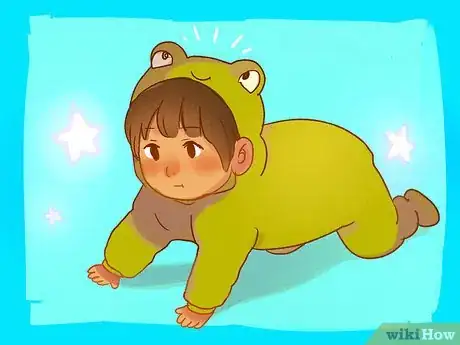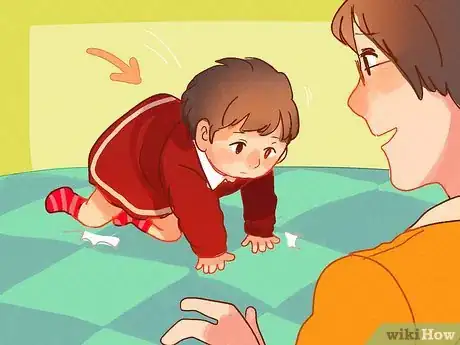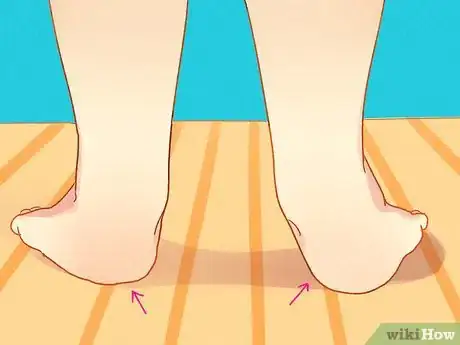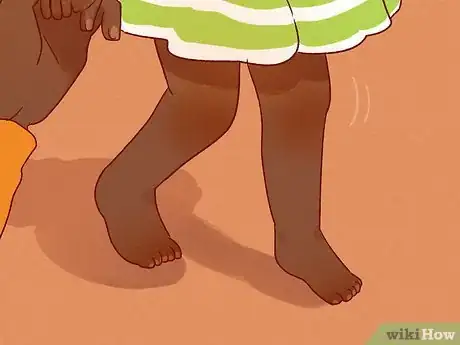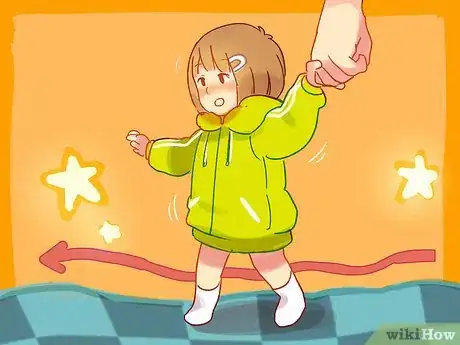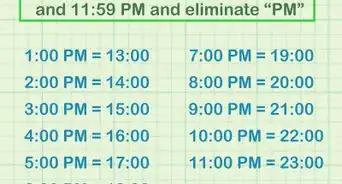This article was co-authored by Kylee Money. Kylee Money is a Parenting Consultant and the Founder and CEO of Parenting Made Joyful. Since 2001, Kylee has worked with over 1,000 parents and families on sleep training, behavior management, potty training, and more. She is a contributing writer and board advisory member at Pampers.com, a CBS News Parent Expert, and featured on Fox and Friends and Buy Buy Baby. Kylee also speaks nationally at parenting expos on the subject of sleep training.
There are 11 references cited in this article, which can be found at the bottom of the page.
wikiHow marks an article as reader-approved once it receives enough positive feedback. This article has 30 testimonials from our readers, earning it our reader-approved status.
This article has been viewed 487,545 times.
Most babies begin walking some time between 10 and 18 months old.[1] But they have to go from crawling to pulling up to cruising to get there. Keep in mind all babies are different, so your baby may have to really work to learn how to walk or just start walking out of the blue. The key is lots of encouragement and practice to get your baby comfortable with walking.
Steps
Helping Your Baby To Stand
-
1Have your baby bounce on your lap with their feet on your legs. This will strengthen their leg muscles, especially if they are still crawling or just starting to pull themselves up.[2]
- You should also show them how to bend their knees and have them practice bending their knees so they develop the motor skills to stand up and sit down.
-
2Get your baby a bouncy chair. At around 5 to 6 months of age, provide your baby with a bouncy chair that will help them to start building their leg muscles.[3]
- Avoid getting your baby a walker as The American Academy of Pediatrics (AAP) discourages the use of walkers for babies. Studies show they can actually slow motor development and cause back problems for babies. They are also a safety hazard, as walkers can tip over or roll down stairs.[4]
- Walkers are banned for use in Canada and the AAP is recommending the U.S. take the same measure against walkers.[5]
Advertisement -
3Use toys to entice your baby to stand. Place a toy just out of reach of your baby, above them, or located in a spot they have to stand to get to.[6]
-
4Help your baby sit back down once they are standing up on their own. Most babies start to get up onto their feet on their own, before they know how to get back down, so don’t be alarmed if your baby cries for help while in the standing position.[7]
- Rather than pick them up when they start to fuss, help them learn to sit down by gently bending their knees and supporting their weight until they reach the floor safely.
Helping Your Baby to Cruise
-
1Line up your furniture so your baby can cruise more easily. Cruising is when your baby starts to use the furniture and other surfaces/objects as support as they begin to walk around. Move your furniture into a stable line, making sure it is all baby-proofed of course, so your baby can easily cruise around on their own.[8]
- In fact, once your baby starts to cruise, it’s a good idea to childproof your home again, as they can reach new heights, and possibly, new hazards.[9]
- Help your baby let go of the furniture as they cruise by holding out your fingers and allowing them to grip you with both hands. Soon enough, they'll be holding on to you with one hand or even letting go altogether.[10]
-
2Get your baby a push toy. A push toy, like a small shopping cart, or a pint-sized lawn mower, will support your baby as they practice cruising. It will also give them control as they learn to walk, refines their balance, and boosts their confidence.[11]
- If your baby is just starting to cruise on their own, start with a toy that does not have wheels. Once you are confident your baby is strong enough, introduce a push toy with wheels.
- Always check that the push toy is sturdy, and has a bar or handle that has a good grip, as well as big wheels, as this will make it harder for the toy to tip over.[12]
-
3Pull your baby up into a standing position. Allow your baby to grip your fingers and pull them up to a standing position, so they are basically supporting their own weight. Let them walk around as you support them under their arms.
- The most time your baby spends exercising their legs, the sooner they will begin to try to take steps on their own.
- Holding your baby as they stand will also help their legs to straighten out and prevent them from bowing later. Bowed legs typically go away by the time your baby is 18 months old, but this issue can linger until they are 3 years old.[13]
-
4Praise your baby for their efforts. Most babies seem born with an inherent desire to please their parents, and receive praise, claps, and shouts of encouragement. So let your baby know when they are doing a great job at standing or cruising by offering them visible encouragement and praise.
-
5Don’t buy indoor walking shoes for your baby. There is no need to invest in a shoe collection for your little one, as the best shoes for your baby are no shoes at all.[14] [15]
- As long as the indoor surfaces are clean and safe for your baby to walk on, let them walk and explore barefoot (or, if you’d prefer, non-slip socks) as much as possible to help build muscle tone in their feet and ankles, help their arches develop, and help them learn balance and coordination.
- If your baby is going to be walking outdoors, in most cases they should be fine going barefoot. If there is a need for footwear due to heat, cold or unsafe surfaces, make sure their shoes are lightweight and flexible. Avoid tall booties or high-top sneakers as too much ankle support can actually slow down your little one by constricting their movement.
-
6Avoid trying to force your baby to stand or walk with your help if they don’t want to. This can instill fear in your baby and delay them from standing or walking.[16]
- Many babies will walk when they are ready, so don’t be alarmed if your baby doesn’t start walking until they are 18 months old, or possibly, older than 18 months.[17]
Helping Your Baby to Walk
-
1Turn balancing into a game. To encourage your baby to get used to balancing on their own two feet, try to make balancing a fun game, with lots of encouragement and praise.[18]
- Sit on the floor with your baby and help them to stand up. Then, count out loud how long they can stay up before they tumble down. Clap and praise them after each balancing attempt.
-
2Encourage your baby to walk, instead of sit. Do this by placing them down in a standing position, as opposed to a sitting position on their butt.[19]
-
3Stand on the other side of the room and encourage your baby to walk towards you. This might help your baby to be confident and motivated enough to take their first steps.
-
4Make their first steps into a big deal. The first steps are a big moment for your little one, so be sure to be as excited and encouraging as possible about your baby’s first steps.[20]
- Cheering your baby as they walk indicates they are doing something right and will give them the confidence to keep walking.
-
5Expect some stops and starts. Don’t be too alarmed if your little walker goes back to crawling after a bad fall or an illness. Your child is also working on other developmental feats like sounding out names or tackling finger foods, so they may take a few weeks or even a month, break from walking.[21]
- Some babies may be more comfortable at first with crawling so they may do the crawl/walk before they fully embrace walking.[22]
-
6Let your baby fall, as long as it is safe. When your baby starts to walk, they may bob, weave, and even take a dive as they try to refine their walking skills. As well, most babies don’t have good depth perception so they tend to bump into or fall into things rather than walk right up to them.[23]
- As long as your home is childproofed for a walking baby and you watch them carefully at all times, don’t stress about their inevitable and numerous tumbles. They may cry when they fall, but chances are they are more frustrated than injured.
- Their diaper and little tush will work as built-in bumpers for any falls, and they will likely forget their trips and tumbles before you do. Avoid making a big deal out of little falls as they learn how to walk on their own.
Supporting Your Baby as They Walk
-
1Avoid comparing your baby’s development to other babies. Not all babies are the same, so don’t be alarmed if your baby isn’t walking at a certain age. The time it takes for a baby to reach a particular milestone, like walking, can vary due to different body weights or even different personalities. Keep in mind a walking timeline is an approximation and not set in stone or an absolute requirement for every baby.[24]
- Some babies who are born prematurely may have more trouble reaching milestones at the same rate as other children born at full-term.
- As well, sometimes babies are just frightened of letting go of your fingers and taking their first steps. So it’s very important to encourage and support your baby as they learn to walk and not to put too much pressure or stress on them.
-
2Don’t be alarmed if it looks like your baby has flat feet. In fact, it’s just baby fat plumping their feet up. By around age 2 to 3, that extra “fluff” on their feet should melt away and you should be able to see their natural arches.[25]
- Their feet may also curve inward, appearing like half moons, which is another infant holdover. Over time, their feet should straighten out.
-
3Be assured your baby’s pigeon-toed feet will straighten out on their own. Also commonly known as “toeing-in”, pigeon-toed feet come from an internal tibial torsion, meaning your baby’s shinbones are turned inward.[26]
- This will correct on its own within six months of your baby’s first steps.
- If your baby still has pigeon-toed feet after six months, ask your pediatrician about stretching exercises to correct the problem.
-
4Check your baby’s feet to make sure they can flatten them. Some babies will have a natural desire to walk around on their tiptoes, which actually helps them develop their sense of balance. This is almost always a quirk that will go away on its own, but rarely, it can be an indication of a too-tight muscle in your baby’s heels or feet.[27]
- If your baby cannot physically flatten their feet on their own, or if they are walking on their tiptoes past the age of 3, let their pediatrician know, as this could be a sign of a developmental issue.
-
5Consult with your pediatrician if your baby falls excessively, their legs seem very stiff, or they continually stumble to one side. There may be signs of possible nerve, joint, or spinal issues.[28]
-
6Let your baby explore as they get more comfortable with walking. As they gain more confidence and becomes more comfortable with walking on flat, smooth surfaces, allow them to also try walking on an incline or on uneven surfaces. These new environments will help to develop your baby’s sense of balance.[29]
Community Q&A
-
QuestionIs it normal for a 17 month old baby to cruise around, not walk?
 Community AnswerIt may be that your baby is just getting used to walking. If you are really worried, you can ask your child's doctor.
Community AnswerIt may be that your baby is just getting used to walking. If you are really worried, you can ask your child's doctor. -
QuestionMy baby is 1 year old. When ever she tries to stand up by support, she only stands on her toes. What do I do?
 Community AnswerThat's normal. Help the baby to walk by holding her hands and "walking" around the room.
Community AnswerThat's normal. Help the baby to walk by holding her hands and "walking" around the room. -
QuestionHow to make my baby stand independently without any problems? My baby is 10 months old and he has a fear of standing up.
 Community AnswerDon't force him to stand up he is only 10 months old. Give him your hands if he will take them, but if he is not happy then simply give him some time.
Community AnswerDon't force him to stand up he is only 10 months old. Give him your hands if he will take them, but if he is not happy then simply give him some time.
References
- ↑ http://www.brillbaby.com/teaching-baby/physical-development/baby-crawling-walking/learning-to-walk.php
- ↑ http://www.babble.com/baby/teaching-baby-walk/
- ↑ http://www.brillbaby.com/teaching-baby/physical-development/baby-crawling-walking/learning-to-walk.php
- ↑ http://www.healthychildren.org/English/safety-prevention/at-home/Pages/Baby-Walkers-A-Dangerous-Choice.aspx
- ↑ http://www.parents.com/baby/development/walking/help-baby-learn-to-walk/#page=11
- ↑ http://www.whattoexpect.com/first-year/first-steps/
- ↑ http://www.brillbaby.com/teaching-baby/physical-development/baby-crawling-walking/learning-to-walk.php
- ↑ http://www.whattoexpect.com/first-year/first-steps/
- ↑ http://www.babble.com/baby/teaching-baby-walk/
- ↑ http://www.brillbaby.com/teaching-baby/physical-development/baby-crawling-walking/learning-to-walk.php
- ↑ http://www.whattoexpect.com/first-year/first-steps/
- ↑ http://www.whattoexpect.com/first-year/first-steps/
- ↑ http://www.whattoexpect.com/first-year/first-steps/
- ↑ http://www.whattoexpect.com/first-year/first-steps/
- ↑ Kylee Money. Parenting Consultant. Expert Interview. 21 May 2021.
- ↑ http://www.babycentre.co.uk/x556547/how-can-i-encourage-my-14-month-old-to-walk
- ↑ http://www.babycentre.co.uk/x556547/how-can-i-encourage-my-14-month-old-to-walk
- ↑ http://www.parents.com/baby/development/walking/help-baby-learn-to-walk/#page=8
- ↑ http://www.parents.com/baby/development/walking/help-baby-learn-to-walk/#page=9
- ↑ http://www.parents.com/baby/development/walking/help-baby-learn-to-walk/#page=9
- ↑ http://www.whattoexpect.com/first-year/first-steps/
- ↑ http://www.parents.com/baby/development/walking/help-baby-learn-to-walk/#page=10
- ↑ http://www.whattoexpect.com/first-year/first-steps/
- ↑ http://www.babble.com/baby/teaching-baby-walk/
- ↑ http://www.whattoexpect.com/first-year/first-steps/
- ↑ http://www.whattoexpect.com/first-year/first-steps/
- ↑ http://www.whattoexpect.com/first-year/first-steps/
- ↑ http://www.whattoexpect.com/first-year/first-steps/
- ↑ http://www.brillbaby.com/teaching-baby/physical-development/baby-crawling-walking/enjoying-the-journey.php
About This Article
Teaching your baby to walk takes time, but you can start by encouraging them to stand by helping them up onto their feet. As they stand, count out loud so they hear how long they can stand for before they tumble down. Once they're comfortable standing up, help your baby cruise around the room while holding onto a table or chair for stability. Later on, when your baby gets used to this, try helping them up, standing on the other side of the room, and encouraging them to walk towards you. For tips on when to consult a pediatrician about your baby, read on!

